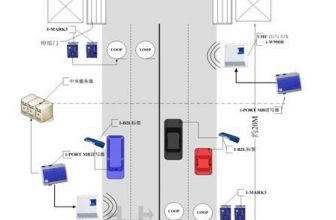
Internet of Things Asset Management System for a Public Security Unit in Gansu
[ad_1]
1. Introduction of electronic tags based on Internet of Things technology
1.1 Basic definition: Electronic tags are also called radio frequency tags, transponders, and data carriers; readers are also called reading devices, scanners, reading heads, communicators, and readers (depending on whether the electronic tags can rewrite data wirelessly). The electronic tag and the reader realize the spatial (non-contact) coupling of the radio frequency signal through the coupling element; in the coupling channel, according to the timing relationship, the energy transfer and data exchange are realized.
1.2 Working frequency: -125KHZ; -13.56MHz; -915MHz; -2.45GHz; -5.8GHz
1.3 Components: The most basic electronic tag system consists of three parts: Tag: consists of coupling elements and chips, each tag has a unique electronic code, high-capacity electronic tags have user-writeable storage space, attached Identify the target object on the object; Reader: a device that reads (and sometimes writes) tag information, which can be designed as a handheld or fixed type; Antenna: Transmit radio frequency between the tag and the reader Signal.
1.4 Features: Data storage: Compared with the traditional form of tags, the capacity is larger (1bit-1024bit), the data can be updated at any time, and can be read and written. Reading and writing speed: Compared with bar codes, there is no need to align and scan in a straight line, and the reading and writing speed is faster, and it can recognize multiple targets and motions. Easy to use: small size, easy to package, can be embedded in the product. Security: The dedicated chip and the serial number are unique and difficult to copy. Durable: no mechanical failure, long life, and resistance to harsh environments.
1.5 The system infrastructure is as follows:
When the equipment equipped with the electronic tag approaches the reader within the range of 0~10 meters, the reader will send out a microwave inquiry signal under control. After the electronic tag installed on the surface of the equipment receives the inquiry signal from the reader, this signal will be connected to the tag. The data information in the composite is integrated and reflected back to the electronic tag reading device. The reflected microwave synthesis signal already carries electronic tag data information. After the reader receives the microwave synthesis signal reflected by the electronic tag, it can separate and read the information such as the identification code stored in the electronic tag after being processed by the internal microprocessor of the reader.
1.6 Working principle:
The basic working principle of RFID technology is not complicated: after the tag enters the magnetic field, it receives the radio frequency signal from the reader, and uses the energy obtained by the induced current to send out the product information (PassiveTag, passive tag or passive tag) stored in the chip. Or actively send a signal of a certain frequency (ActiveTag, active tag or active tag); after the reader reads the information and decodes it, it is sent to the central information system for relevant data processing.
The RFID (Radio Frequency Identification) system consists of two parts: a read/write unit and an electronic transceiver. The reader sends out electromagnetic pulses through the antenna, and the transceiver receives these pulses and sends the stored information to the reader as a response. In fact, this is the non-contact read, write or delete processing of the data in the memory.
Technically speaking, a “smart tag” includes an RFID circuit that includes an RFID chip with an RFID radio frequency part and an ultra-thin antenna loop, which is embedded in the tag together with a plastic sheet. Usually, a paper label is attached to this label, and some important information can be clearly printed on the paper label. The current smart labels are generally the size of a credit card. For small goods, there are labels with a size of 4.5×4.5 cm, and there are also circular labels with a diameter of 4.7 cm used on CDs and DVDs.
Compared with other ID technologies like barcodes or magnetic strips, the advantage of transceiver technology lies in the wireless link between the reader and the transceiver: the read/write unit does not require visual contact with the transceiver, so it can Fully integrated into the product. This means that the transceiver is suitable for harsh environments, and the transceiver is not sensitive to moisture, dirt, and mechanical influences. Therefore, the transceiver system has very high read reliability, fast data acquisition, and the last and important point is to save labor and paper.

2. Single police equipment management system
System construction background of single police equipment management system
The Ministry of Public Security promulgated the “Public Security Single Police Equipment Standards”. In order to strengthen the equipment of front-line police and improve the protection and combat effectiveness of the police, the police will be equipped with corresponding police equipment according to the work requirements of different police types. There are two types of “must” and “optional”. The current requirements of the Ministry of Public Security include police uniforms, batons, handcuffs, tear gas jets, glare flashlights, police-standard knives and other mandatory items, guns, walkie-talkies, There are 15 kinds of optional items such as police pass, stab-resistant clothing and police equipment package. If all the items are complete, a single police equipment is expensive. Since the assembly has to be distributed to every police officer, it is difficult to manage by manual recording or ordinary management tools.
Overview of Single Police Equipment Management System
“Public Security Single Police Equipment Management System” is based on the Internet of Things and uses radio frequency technology electronic tags to identify the equipment of front-line police. As the ultimate product, electronic tags are not restricted by “cards”, and there are also colorful development space for shapes and materials. Its products can be divided into three categories: labels, injection molding and cards. The biggest difference between the radio frequency technology electronic label and the ordinary bar code is that the bar code is a “visual technology”. The scanner works under the guidance of a person and can only receive the bar code within its field of view. In contrast, radio frequency identification does not require seeing the target. The radio frequency tag can be read as long as it is within the range of the receiver. The barcode itself has other shortcomings. If the label is scratched, contaminated or peeled off, the scanner will not be able to identify the target. Bar codes can only identify producers and products, but cannot identify specific equipment. Bar codes affixed to all the same equipment are the same and cannot provide a complete set of data for the life cycle management of the entire equipment.
The radio frequency technology electronic label carries out a uniform number for each single police equipment. The real-name system is used for distribution and the electronic label code is used in the management process. It is a combination of the unique code of its own equipment and a randomly generated electronic code. It is the only electronic device for each equipment. Label coding has high reliability, safety and uniqueness. It fully embodies the standardized management principles of “who is in charge, who is responsible”, “who handles, who is responsible”, and “who uses and who is responsible”;
On the basis of fully researching the equipment management business requirements of the Public Security Bureau, Yingmijia has developed the “Public Installation Equipment Management System”. The use of electronic tags based on the Internet of Things using radio frequency technology to complete the daily management and inventory work of each equipment, so as to efficiently achieve the full tracking of the distribution and use status of the equipment, and the life cycle management of the equipment, from a technical point of view It guarantees to the greatest extent that the equipment accounts are consistent with each other, reduces the work intensity of entry, and avoids the repeated purchase or loss of police equipment. Comprehensively improve the management level of the equipment of the public security department, and make the management of police equipment easier.
Single police equipment management system function module
Equipment inventory management: equipment storage, equipment delivery, equipment allocation, inventory inventory
Equipment distribution management: equipment acquisition, equipment replacement, equipment return
Query statistics management: single police equipment query, equipment storage and exit query, equipment distribution query, equipment inventory query,
System management: operator/authority, department/personnel information, equipment classification code, data dictionary management
Label production: electronic label generation
Advantages of single police equipment management system
The system provides a powerful electronic tag synthesis function,
Collection terminal for equipment asset data collection and inventory, accurate and efficient
Realizes the entire monitoring and tracking of the single police equipment during the life cycle
Powerful data import and export functions facilitate data exchange and docking with other systems.
3. Fixed asset management system
3.1 Overview of the fixed asset system
Fixed asset management is an important part of public security asset management. Fixed assets have the characteristics of large quantity, variety, variety, high value, long service life, scattered use locations, etc., making management difficult. At present, many public security agencies still rely on manual accounting management methods. Due to the large number of management documents and heavy inventory work, a large amount of manpower and material resources are required, and the historical operation of fixed assets and asset statistics are extremely difficult, resulting in asset loss and repeated asset purchases. In recent years, some asset management software has appeared. Although it has solved the problem of manual bookkeeping to a large extent, most systems use manual data entry, which is not only slow and error-prone, but also exists in asset management. The serious problem of the disconnection of accounts is difficult to meet the needs of modern public security asset management.
3.2 Functional modules of the fixed asset system
1. Daily management: asset card management, asset entry, asset transfer, asset maintenance, asset borrowing, asset activation, asset deactivation, asset withdrawal
2. Asset inventory: check inventory list, enter inventory list, inventory profit and loss schedule, inventory summary
3. Depreciation management: accrual depreciation, monthly depreciation report, annual depreciation report, asset impairment preparation, asset value revaluation, accumulated depreciation details
4. Report management: classified detailed statistical report, department detailed statistical report, new asset statistical report, exit asset statistical report
5. System management: operator/authority, department/personnel information, asset classification code, asset attribute information
6. Label production: label definition, label generation
2.3 Characteristics of fixed assets system:
1. With the help of electronic label technology, the system realizes the effective management of assets in kind and eliminates the phenomenon of accounting inconsistencies.
2. Apply wireless mobile technology to realize seamless collection of asset information
3. Provide a powerful data interface and support a variety of external devices.
4. Rich daily management functions make asset tracking easier and more intuitive
5. The system is developed with object-oriented technology to realize the separation of data layer, business layer, and user presentation layer (user interface), and can be connected to various databases.
2.4 Advantages of fixed asset management system:
1. The system provides a powerful label customization function based on the electronic label of the Internet of Things, and public security customers can customize the asset label style of their own unit.
2. Support different modes of electronic tags to meet the orderly management of assets with different attributes.
3. Use the data interpreter terminal to collect and check asset data, which is accurate and efficient.
4. Realize the whole-process monitoring and tracking of the asset’s physical life cycle
5. Powerful data import and export functions, convenient for data exchange and docking with other systems.
[ad_2]




